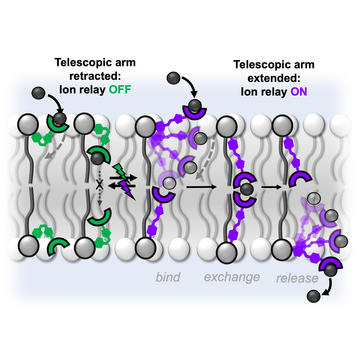A new study from the Langton group, which describes a novel approach to deliver and control molecular machine ion transporters in lipid bilayer membranes, has been highlighted as a Hot Paper in Angewandte Chemie.

A molecular machine based ion transport relay controlled by light
Ion transport across cell membranes is a fundamental process in nature. Research on artificial stimuli-responsive ion transport systems, which can move ions across lipid bilayers, aims to develop new therapeutics to treat the diseases that occur when natural ion transporters malfunction.
Relay ion transporters act as a type of molecular machine. When they are positioned either side of a lipid bilayer membrane, they can pass ions between them and across the membrane (see schematic). DPhil student Elin Grählert has developed aryl azopyrazole photo-switchable ion transporter relays, in which the transmembrane ion transport process can be efficiently modulated by light. Photoisomerisation changes the length of the relay “telescopic arms”. This allows the activity to be switched on and off, because when the arm is retracted ions cannot be passed between them.
The relays are derived from functionalised phospholipids, which means that they cannot translocate across the membrane themselves. This feature has limited their applicability to artificial cells where they can be more easily incorporated into the membrane. This work demonstrates that an artificial “flippase” molecule could be used to deliver the relay transporters to both leaflets of the membrane, opening up future applications of relay transporters in both synthetic and living cells.
This research was generously funded by the EPSRC Centre for Doctoral Training in Inorganic Chemistry for Future Manufacturing (OxICFM).
The published work is openly available at: https://onlinelibrary.wiley.com/doi/10.1002/anie.202421580